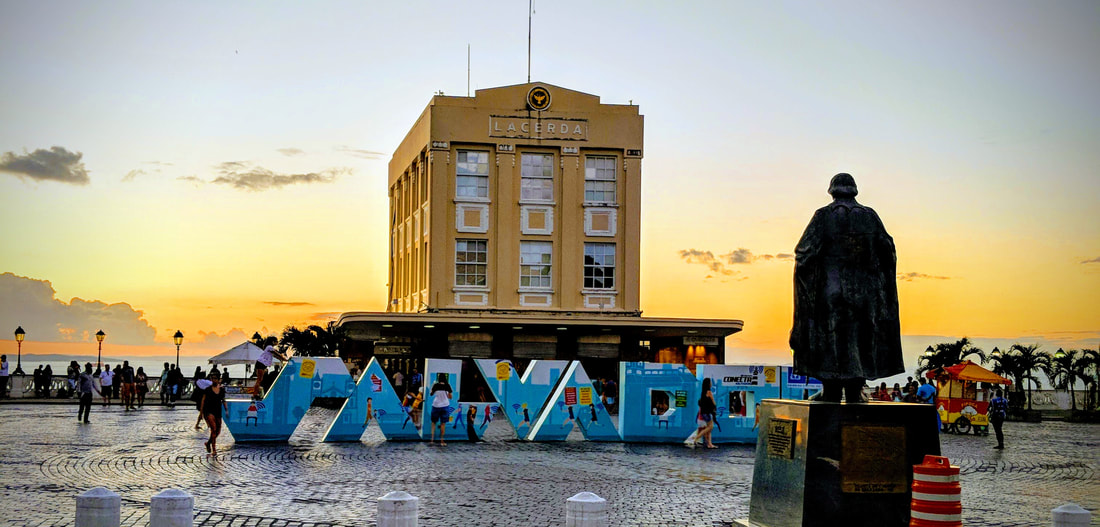|
By Kate McGlinch Though I have learned so much in exploring Salvador, Brazil and attending the lectures, I found my experience in the Emergency Room here especially intriguing. On May 18th, I had developed some concerning symptoms and was taken to Hospital Português by my professor. This is a private hospital though it seems to operate more largely as a Catholic nonprofit organization. Brazil’s healthcare is a combination of public and private healthcare systems. While I went to a private hospital where I paid a bill at the end of my time there, I also had the option (even as a foreigner) to be seen by doctors for free. I was broadly aware of this situation as our class was visited by Professor Clarice Mota who had explained how healthcare in Brazil works prior to our trip. According to her presentation, public healthcare has been provided to all Brazilian citizens as well as foreigners since the implementation of Sistema Único da Saúde (SUS) in the late 1980s. Though access to efficient and effective healthcare is not necessarily equitable, every citizen is entitled to the same right to healthcare today (Mota, 2022). My experience of Hospital Português was good; It took no more than 30 minutes between my arrival to the emergency room and my blood being drawn. The waiting rooms were quiet and calm, the nurses did not seem incredibly stressed or overworked, and I was treated with professionalism. Having gone to the emergency room in the United States earlier this year, I was surprised by the contrast in experiences. In February, I was in a car crash that left me with a lot of head and neck pain. I had considered taking an ambulance to the ER as I found driving to be difficult, but the cost for a 20 minute ambulance ride would have been more than the amount I paid for the entirety of my time and service at Hospital Português (even relative to Brazilian reals). I went to the ER at St. Cloud Hospital, also a Catholic-affiliated nonprofit institution. Though my vitals were taken after about 30 minutes, I was sent back out to the waiting room until I could be seen by a physician. 5 hours later, there was still no movement, people in similar positions to myself were anxiously checking their watches. I went home and took as much Ibuprofen as possible. Though Brazil’s investment in public access to healthcare is impressive compared to the United States’ marginal attempts at something similar through Medicare or Medicaid, there have been some noteworthy issues. As mentioned before, though everyone has a right to healthcare in Brazil, the amount of ease with which different individuals can access it varies quite a bit. Since Brazil is a very large country, one of the factors contributing to inequality in access and efficacy of healthcare is geography. An article by KPMG points out that “there are huge challenges in providing quality healthcare to all Brazil's 209 million citizens. The south-east around Rio de Janeiro is relatively prosperous while much of the north of the country is far poorer in terms of education, economic output and access to care. Maternal mortality rates are significantly higher in the north-east” (Greca and Fitzgerald, 2022). Though my experience of a hospital in Salvador was positive, I feel the fact that I was being cared for in a private hospital that doesn’t rely as heavily on government funding and maintenance may have contributed quite a bit to my perspective. Furthermore, these private hospitals seem to be receiving more funding from the government than needed, essentially depriving the public sector of needed financial resources. The Journal of Global Health has noted that the financial base of Brazil’s healthcare system “has resulted in a situation where less than 30% of Brazilians who continue to use private health insurance and facilities constitute more than 50% of the total health care expenditure in Brazil …the legacies of the previous discriminatory health care system are still in operation and the constitutional principle of universality is yet to be realized in practice” (Muzaka, 2017). These inequalities in funding manifest especially in the quality of care for black Brazilians as structural racism assures that the majority of these people are in the lower class and have no other options than SUS and public hospitals for healthcare (Constante, Marino and Bastos, 2021). My experience as a white foreigner in a private hospital, especially in the northeast region of Brazil, was likely not common to the usual experience here. Nevertheless, I found it interesting to observe the private healthcare system here in Brazil and compare my experience with those that I have had in the U.S.. Mota, Clarice. “Social Inequities in Brazil: Effects and Outcomes in Life and Health Conditions.” Lecture, College of St. Benedict and Saint John’s University, St. Joseph, MN, April 12, 2022. Greca, Daniel and Edward Fitzgerald. 2022. “Healthcare in Brazil: Meeting Future Challenges.” KPMG. Retrieved from https://home.kpmg/xx/en/home/insights/2019/04/meeting-healthcare-challenges-in-brazil.html. Muzaka, Valbona. 2017. “Lessons From Brazil: On the Difficulties of Building a Universal Healthcare System.” Journal of Global Health 7, no. 1 (June). 10.7189/jogh.07.010303. Constante, Helena Mendes, Gerson Luiz Marinho, and João Luiz Bastos. 2021. “The Door is Open, But Not Everyone May Enter: Racial Inequities in Healthcare Access Across Three Brazilian Surveys.” Ciência Saúde Coletiva 26, no. 9 (September). https://doi.org/10.1590/1413-81232021269.47412020.  Kate McGlinch is a sophomore at CSB/SJU with a major in Political Science and a minor in Philosophy. She is from St. Paul, Minnesota. Her academic interests include justice and reformation in politics as well as policy for social issues. She looks forward to understanding Brazilian politics and culture in a more holistic way while studying abroad.
0 Comments
Leave a Reply. |
Archives
June 2024
Categories
All
|

 RSS Feed
RSS Feed
